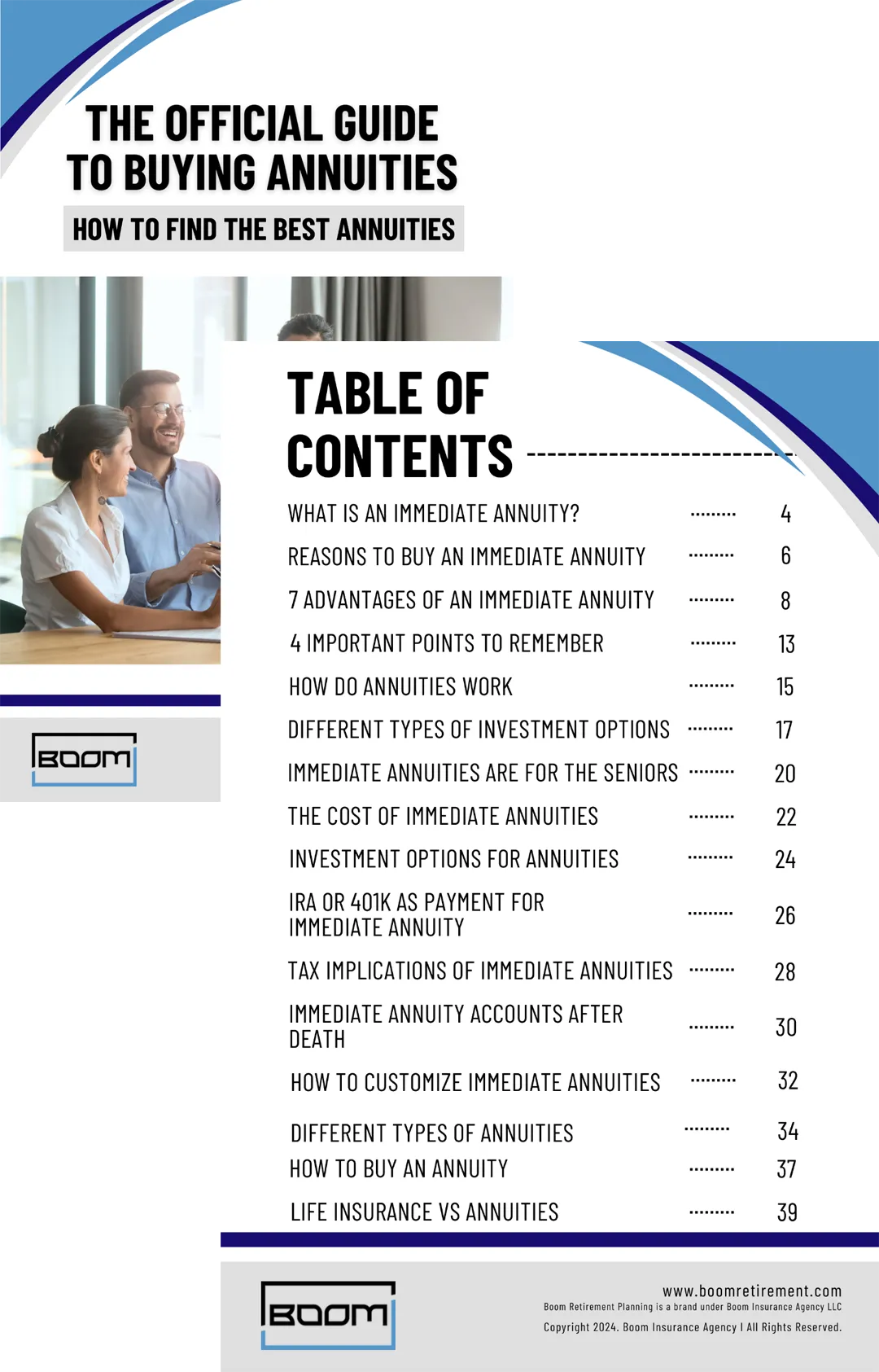
BOOM RETIREMENT SOLUTIONS
Strategies for Boosting Retirement Income

Top Retirement Cash Flow Risks
Why you need this Retirement Toolkit
Will outlive your retirement savings?
Will taxes and inflation erode your Retirement Nest Egg?
Will you head into retirement using an Accumulation Strategy or a Decumulation Strategy?
Will you maintain your lifestyle in a market downturn?
Are you prepared for RMD's and IRMAA?
BOOM RETIREMENT PLANNING
Strategies for Boosting Retirement Income
If You Ask 50 Financial Advisors,
"What is the best way to retire?".
You will get 50 different answers!
That is because despite all their training and certifications,
financial advisors each bring their own perspectives, experiences, and
biases to the table, leading to varied approaches and strategies tailored to their
unique understanding of the market, client needs, and risk tolerance.
Economic Science and Math proves...
There is Only One Optimal Way to Retire
Over 6 Decades of Research Created the 7 Steps Below.
Develop a Plan: Assess your financial situation, retirement goals, income sources and monthly budget for expenses.
Secure Lifetime Income: Consider products like private pensions for guaranteed income.
Maximize Social Security: Optimize benefits by understanding your options; delaying to 67 or 70 can help.
Diversify Investments: Build a balanced portfolio—30% cash value life insurance, 30% lifetime income, 40% growth assets.
Prepare for Health Care Costs: Budget for health expenses, including long-term care, which most seniors will need.
Use Tax-Efficient Strategies: Consider Roth conversions to reduce retirement taxes.
Stay Active and Engaged: Pursue activities for mental, physical, and emotional well-being in retirement.
Our Blog

Fixed vs. Variable Annuities – Which Option is Best for Your Retirement?
Decoding Annuities: Fixed vs. Variable – Which Option is Best for Your Retirement?
By Jeff Weidner
Planning for retirement means ensuring you have a reliable income source that will carry you through your golden years. Annuities can be a great solution for this, but with different types available, how do you know which one is right for you? In this guide, we’ll break down fixed and variable annuities, exploring their pros and cons to help you decide which option best suits your retirement needs.
What Is an Annuity?
An annuity is essentially a contract between you and an insurance company. You pay the insurance company a sum of money, and they agree to provide you with regular payments in the future. Annuities are popular because they offer a structured, reliable income stream, which can be especially helpful in retirement. They also offer tax benefits, as your earnings grow tax-deferred until you start receiving payments.
Types of Annuities: Fixed vs. Variable
When it comes to annuities, there are several types to choose from, but fixed and variable annuities are two of the most common. Let’s explore each in detail.
Fixed Annuities: Stability and Predictability
A fixed annuity provides a guaranteed interest rate over a specific period, so you know exactly how much you’ll earn. This type of annuity is similar to a Certificate of Deposit (CD), but usually offers higher interest rates and tax-deferred growth. A Fixed Annuity should not be confused with a Fixed Index Annuity. Fixed Index Annuities are more like Bonds, have higher rates of return and offer more flexibility.
How Fixed Annuities Work
You make a deposit: This could be a lump sum or a series of payments.
Interest is added: The insurance company applies a fixed interest rate to your balance.
Payout phase begins: You start receiving regular payments after the accumulation period, either for a set number of years or for life.
Pros of Fixed Annuities
Guaranteed interest rate: Your principal and earnings are protected from market downturns.
Tax-deferred growth: You don’t pay taxes on your earnings until you begin withdrawing.
Predictable payments: Easy to plan around for budgeting purposes.
Cons of Fixed Annuities
Lower growth potential: The returns might be lower than other investment options, especially in a strong market.
Inflation risk: The fixed rate may not keep up with inflation, reducing purchasing power over time.
Limited flexibility: Early withdrawals can lead to significant penalties.
Variable Annuities: Potential for Growth with Added Risk
Variable annuities offer the potential for higher returns by investing your money in a selection of sub-accounts similar to mutual funds. This means your earnings vary depending on how well these investments perform.
How Variable Annuities Work
You invest in sub-accounts: These could be stocks, bonds, or other securities.
Value fluctuates with the market: Your balance can increase or decrease based on the performance of the sub-accounts.
Payout phase starts: You begin receiving payments, but the amount may vary depending on the current value of the account.
Pros of Variable Annuities
Higher growth potential: Variable annuities can offer significant returns during a strong market.
Tax-deferred growth: Like fixed annuities, you won’t pay taxes on earnings until withdrawal.
Investment options: Choose different sub-accounts based on your risk tolerance and goals.
Cons of Variable Annuities
Market risk: Your balance could decrease if the market performs poorly.
Complexity: Variable annuities can be complicated, with numerous investment options and fees.
Higher fees: They tend to have higher costs due to active management of the sub-accounts.
How to Choose Between Fixed and Variable Annuities
The choice between fixed and variable annuities depends on factors like your risk tolerance, retirement goals, and time horizon.
Consider Your Risk Tolerance
Low risk tolerance: A fixed annuity may be better, as it provides stability and guaranteed growth.
Higher risk tolerance: A variable annuity may suit you if you’re comfortable with market fluctuations and seek higher potential returns.
Think About Your Time Horizon
Longer time horizon: If retirement is years away, you might benefit from the growth potential of a variable annuity.
Closer to retirement: Fixed annuities offer the security of guaranteed returns, which can be helpful as you near retirement.
Evaluate Your Need for Liquidity
If you anticipate needing access to your funds before the annuity matures, fixed annuities might be a better choice, as variable annuities may have more restrictions and higher early withdrawal penalties.
FAQs About Annuities
What are the different types of annuities?
Annuities come in various forms, including:
Immediate annuities: Start paying out almost immediately.
Deferred annuities: Payments begin at a later date.
Fixed annuities: Offer a guaranteed interest rate.
Fixed indexed annuities: Combine fixed rates with growth potential based on a market index.
Variable annuities: Invest in sub-accounts tied to the stock market.
How do annuities compare to CDs?
Annuities, especially fixed ones, are similar to CDs but often offer better rates and tax-deferred growth. Unlike CDs, annuities can provide lifetime income, making them a better choice for retirement income.
Are there tax benefits to owning an annuity?
Yes, annuities allow for tax-deferred growth, meaning you don’t pay taxes on your earnings until you start making withdrawals. This can be a valuable feature for long-term retirement planning.
Can I lose money in an annuity?
In a fixed annuity, your principal is generally safe. However, with a variable annuity, your balance depends on market performance, so losses are possible.
When is the best time to buy an annuity?
Many people purchase annuities in their 50s or 60s as they approach retirement and want to secure a reliable income source.
FAQs About Boom Retirement Solutions
Who is Boom Retirement Solutions?
Boom Retirement Solutions is a hypothetical example of a retirement planning firm specializing in tax-advantaged products like annuities.
How can Boom Retirement Solutions help with annuities?
Boom Retirement Solutions offers personalized advice on choosing the right type of annuity for your retirement. They can help you understand the benefits of each type and structure them for maximum income and tax efficiency.
What makes Boom Retirement Solutions unique?
Their approach is client-focused, aiming to create a retirement plan that balances guaranteed income, growth potential, and tax benefits tailored to your unique goals.
Get Expert Help for a Secure Retirement
Deciding between a fixed or variable annuity is a significant decision that can shape your retirement income for years to come. It’s wise to seek guidance from a qualified financial advisor to explore how an annuity could fit into your overall retirement plan. A professional can help you weigh your options, consider tax implications, and choose the product that aligns best with your financial goals.
If you’re ready to dive deeper into the benefits of annuities, Boom Retirement Solutions can provide a tailored consultation to help you make informed decisions for your future.
Taxation can play a substantial role in determining
the overall value of your retirement portfolio
How are your current retirement income sources taxed?
Social Security
Qualified Accounts
Non-Qualified Accounts
Social Security is a federal government program in the United States that provides financial benefits to eligible individuals, primarily retirees, disabled individuals, and their families. It is funded through payroll taxes collected under the Federal Insurance Contributions Act (FICA) and the Self-Employment Contributions Act (SECA).
Key components of Social Security include:
Retirement Benefits: These benefits are available to workers who have paid into the Social Security system through payroll taxes during their working years. Individuals can start receiving reduced retirement benefits as early as age 62, but full benefits are available at the full retirement age, which varies depending on the year of birth. Delaying benefits beyond full retirement age can increase the monthly benefit amount.
Disability Benefits: Social Security Disability Insurance (SSDI) provides benefits to individuals who are unable to work due to a qualifying disability. To be eligible, individuals must have a sufficient work history and meet specific medical criteria.
Survivor Benefits: These benefits are paid to the surviving spouses, children, or dependents of deceased workers who paid into the Social Security system. The amount of the benefit depends on the deceased worker's earnings record.
Supplemental Security Income (SSI): Although administered by the Social Security Administration, SSI is a separate program funded by general tax revenues (not Social Security taxes). It provides financial assistance to elderly, blind, or disabled individuals with limited income and resources.
Social Security is a critical component of retirement planning for many Americans, providing a safety net to ensure a basic level of income in retirement, during periods of disability, or after the death of a family member.
Social Security benefits may be taxed based on your combined income, which includes adjusted gross income, nontaxable interest, and half of your Social Security benefits. Depending on your income level, up to 85% of your benefits could be subject to federal income tax.
A qualified account is a type of retirement savings account that offers tax advantages, typically regulated by the IRS under specific sections of the tax code. Contributions to qualified accounts are often tax-deferred, meaning that contributions are made with pre-tax dollars, reducing the individual's taxable income in the year of the contribution. Taxes on contributions and investment earnings are deferred until withdrawals are made, usually in retirement.
401(k) plans
403(b) plans
457 plans
Traditional IRAs
SEP IRAs
SIMPLE IRAs
Self Directed IRAs
Pensions
Annuities
Withdrawals from these accounts are generally subject to income tax, and there may be penalties for early withdrawals before a certain age (usually 59½). Additionally, qualified accounts are subject to Required Minimum Distributions (RMDs) once the account holder reaches age 73 (if born before 1960).
Required Minimum Distributions (RMDs) are the minimum amounts that retirees must withdraw annually from their tax-deferred retirement accounts, such as traditional IRAs and 401(k)s, starting at age 73 (as of 2023). The amount of the RMD is calculated based on the account balance and the account holder's life expectancy. Failing to take RMDs can result in significant tax penalties, including a hefty excise tax on the amount that should have been withdrawn.
A non-qualified account is a type of investment account that does not have the same tax advantages or restrictions as qualified retirement accounts. Unlike qualified accounts, contributions to non-qualified accounts are made with after-tax dollars, meaning there's no tax deduction for contributions.
Examples of non-qualified accounts include:
Brokerage accounts
Mutual fund accounts
Certificates of deposit
Savings accounts
Roth IRA
Cash Value Life Insurance
Annuities
These accounts are often used for general savings and investments outside of retirement, offering more flexibility in terms of contributions and withdrawals, but without the tax advantages of qualified accounts.
The exception is the Roth IRA in which the principal, interest, earnings and dividends are all tax-free. Roth IRAs are also not subject to RMD's.
A Roth conversion is the process of transferring funds from a Qualified retirement accounts into a Roth IRA (Non-Qualified Account). The converted amount is subject to income tax in the year of the conversion, but future withdrawals from the Roth IRA are tax-free, provided certain conditions are met. This strategy is often used to reduce taxable income in retirement and to avoid required minimum distributions (RMDs).
Books for Retirees and Soon-To-Bes
Choose Your Book
Retirement Income


Tax Strategies




Long Term Care



Boom Final Expense is a brand under Boom Insurance Agency LLC
©Copyright 2023| Boom Insurance Agency. All Right Reserved

Boom Retirement Planning is a brand under Boom Insurance Agency LLC
©Copyright 2024| Boom Insurance Agency. All Right Reserved





